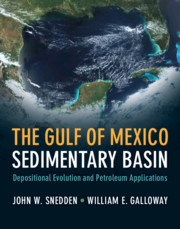Refine listing
Actions for selected content:
1211 results in Ebooks in petroleum sciences
Chapter 2 - Post-Orogenic Successor Basin-Fill and Rifting Phase
- from Part II - Mesozoic Depositional Evolution
-
- Book:
- The Gulf of Mexico Sedimentary Basin
- Published online:
- 13 September 2019
- Print publication:
- 21 November 2019, pp 54-64
-
- Chapter
- Export citation
Index
-
- Book:
- The Gulf of Mexico Sedimentary Basin
- Published online:
- 13 September 2019
- Print publication:
- 21 November 2019, pp 324-326
-
- Chapter
- Export citation
Abbreviations
-
- Book:
- The Gulf of Mexico Sedimentary Basin
- Published online:
- 13 September 2019
- Print publication:
- 21 November 2019, pp xiv-xvi
-
- Chapter
- Export citation
Part II - Mesozoic Depositional Evolution
-
- Book:
- The Gulf of Mexico Sedimentary Basin
- Published online:
- 13 September 2019
- Print publication:
- 21 November 2019, pp 53-164
-
- Chapter
- Export citation
Part III - Cenozoic Depositional Evolution
-
- Book:
- The Gulf of Mexico Sedimentary Basin
- Published online:
- 13 September 2019
- Print publication:
- 21 November 2019, pp 165-246
-
- Chapter
- Export citation
Glossary
-
- Book:
- The Gulf of Mexico Sedimentary Basin
- Published online:
- 13 September 2019
- Print publication:
- 21 November 2019, pp 292-296
-
- Chapter
- Export citation
Part IV - Petroleum Habitat
-
- Book:
- The Gulf of Mexico Sedimentary Basin
- Published online:
- 13 September 2019
- Print publication:
- 21 November 2019, pp 247-291
-
- Chapter
- Export citation
Preface
-
- Book:
- The Gulf of Mexico Sedimentary Basin
- Published online:
- 13 September 2019
- Print publication:
- 21 November 2019, pp xi-xiii
-
- Chapter
- Export citation
Chapter 6 - Cenozoic Depositional History 2
- from Part III - Cenozoic Depositional Evolution
-
- Book:
- The Gulf of Mexico Sedimentary Basin
- Published online:
- 13 September 2019
- Print publication:
- 21 November 2019, pp 191-210
-
- Chapter
- Export citation
Chapter 8 - Cenozoic Depositional Synthesis and Emerging Hydrocarbon Plays
- from Part III - Cenozoic Depositional Evolution
-
- Book:
- The Gulf of Mexico Sedimentary Basin
- Published online:
- 13 September 2019
- Print publication:
- 21 November 2019, pp 231-246
-
- Chapter
- Export citation
Chapter 9 - GoM Petroleum Habitat
- from Part IV - Petroleum Habitat
-
- Book:
- The Gulf of Mexico Sedimentary Basin
- Published online:
- 13 September 2019
- Print publication:
- 21 November 2019, pp 248-291
-
- Chapter
- Export citation
Chapter 5 - Cenozoic Depositional History 1
- from Part III - Cenozoic Depositional Evolution
-
- Book:
- The Gulf of Mexico Sedimentary Basin
- Published online:
- 13 September 2019
- Print publication:
- 21 November 2019, pp 166-190
-
- Chapter
- Export citation
Chapter 1 - Introduction
- from Part I - Introduction
-
- Book:
- The Gulf of Mexico Sedimentary Basin
- Published online:
- 13 September 2019
- Print publication:
- 21 November 2019, pp 2-52
-
- Chapter
- Export citation
Dedication
-
- Book:
- The Gulf of Mexico Sedimentary Basin
- Published online:
- 13 September 2019
- Print publication:
- 21 November 2019, pp v-vi
-
- Chapter
- Export citation
Copyright page
-
- Book:
- The Gulf of Mexico Sedimentary Basin
- Published online:
- 13 September 2019
- Print publication:
- 21 November 2019, pp iv-iv
-
- Chapter
- Export citation
References
-
- Book:
- The Gulf of Mexico Sedimentary Basin
- Published online:
- 13 September 2019
- Print publication:
- 21 November 2019, pp 297-323
-
- Chapter
- Export citation
Chapter 4 - Late Mesozoic Local Tectonic and Crustal Heating Phase
- from Part II - Mesozoic Depositional Evolution
-
- Book:
- The Gulf of Mexico Sedimentary Basin
- Published online:
- 13 September 2019
- Print publication:
- 21 November 2019, pp 101-164
-
- Chapter
- Export citation

The Gulf of Mexico Sedimentary Basin
- Depositional Evolution and Petroleum Applications
-
- Published online:
- 13 September 2019
- Print publication:
- 21 November 2019
15 - Upscaling Petrophysical Properties
- from Part IV - Reservoir Engineering Workflows
-
- Book:
- An Introduction to Reservoir Simulation Using MATLAB/GNU Octave
- Published online:
- 22 July 2019
- Print publication:
- 08 August 2019, pp 558-596
-
- Chapter
-
- You have access
- Open access
- Export citation
8 - Mathematical Models for Multiphase Flow
- from Part III - Multiphase Flow
-
- Book:
- An Introduction to Reservoir Simulation Using MATLAB/GNU Octave
- Published online:
- 22 July 2019
- Print publication:
- 08 August 2019, pp 231-271
-
- Chapter
-
- You have access
- Open access
- Export citation
